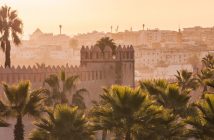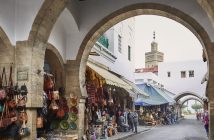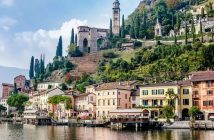The empty ochres of the Atacama Desert roll on for miles and the horizon appears barren. Yet it is pregnant with promise. Set in the very north of Chile, a stone’s throw from Bolivia and Argentina, Atacama has huge natural resources but a low international profile. I came away reeling from what I’d seen, determined to understand its relative obscurity.
Atacama is a place where opposites collide: desert and snow, boiling heat and freezing cold, the Spanish and the indigenous Atacameños, bright sunshine by day and black nights, a home in flourishing Chile, not far from neighbours with more precarious economies. With the stability of Chile behind it and the influence of tourism elsewhere in South America – the Andes, the Inca trail – not to mention everything Atacama itself has to offer, it’s strange that more adventurous types aren’t visiting the world’s driest desert.
It’s a hike to get there, but worth it. I was met by my hotel, Explora, at Calama airport after an internal flight from Santiago. Another hour in a minibus and I was at the hotel, set just on the edge of terracotta town San Pedro de Atacama. Simple yet luxurious, Explora (as its name would suggest) has an ethos of promoting desert activities – hiking, biking, riding, camping, stargazing – all in the diverse surrounding wilderness. No TV or internet in the rooms, but plentiful excitement for the intrepid (and the thirsty – their flowing Pisco Sours were excellent). It was a full-board affair – three-course meals of Chilean steak, local quinoa, Don Melchor Cab Sav, you get the picture – and all activities covered, including the day I spent aboard lovely Suegra (my horse, a dark bay Criollo, whose name translates to the rather less lovely ‘mother-in-law’). As Explora and its (horseless) counterparts would suggest, there’s definitely a market for higher-end adventure tourism in the region, doubtless because the conditions are tough, but there are hostels nevertheless.
The landscapes took my breath away. On my first day, a trip to the Salar de Atacama salt flats at sunset demonstrated the dramatic chemistry between earth and sky, flamingo silhouettes flashing up on a neon horizon. Here lies the world’s biggest natural supply of lithium, a mind-bogglingly valuable resource resembling meringue tips. Then the billowing Tatio geysers, the dizzying 4321km altitude and staggering beauty of which left me gasping. My guide, blue-eyed Oscar, told me that the Atacameños saw volcanoes as their holy protectors and thought the steam coming from them was tears. ‘Tata Iyu’ means ‘grandfather crying’ in the now extinct Cunza tongue, two words the Spanish fused to form the now place name of Tatio.
The Spanish influence here is interesting. The conquistadores were perhaps less barbaric in Atacama than elsewhere on the continent. Local knowledge of the land and how to survive in it was vital, so there seems to have been some concession not to kill every native (don’t get too excited, there are still only about 3,000 of them left). Either side of the church door in the village of Toconao there’s a sculpted picture symbolising each culture – a llama for the locals, a donkey for the Spanish – indicating a degree of compromise.
But Atacama’s wealth isn’t limited to a rich history and natural wonders. The human life that has tapped its wares is now doing so with extraordinary gusto. Two vast copper mines, Chuquicamata and Escondida (the former the world’s largest), and the soon to be completed ALMA Project (Atacama Large Millimeter Array) are just a couple of examples. ALMA, an expensive collaboration between Chile, the States and Europe, is a suite of radio telescopes relying on the kind of flatness and altitude that only Atacama can provide. By 2012, it should provide ground-breaking visibility of the surrounding stars and planet formations where already the stars have a piercing presence. It’s a sweet coincidence that the project’s acronym is the same as the Spanish for ‘soul’. You can’t help but feel you’re staring deep into Atacama’s when you look at the night sky here.
So why is this all so little known to visitors? Silvio Bernasconi, Hotel Manager at Explora’s Hotel de Larache, commented that while ALMA doesn’t yet influence Explora, this could change next year if and when they decide to welcome visitors. Silvio, a Swiss Italian drawn to Latin life, came to Atacama (over Explora’s other destinations of Patagonia or Easter Island) because it was so different from anywhere he’d ever been. He said, “In Chile, they have world class assets and very low key presentation. It’s basically the opposite of Argentina.” Does Atacama pale in the shadows of other South American countries due to lack of marketing, then?
It strikes me that, as far as tourism is concerned, ‘Brand Chile’ survives largely on wine, with some Pablo Neruda and Patagonia thrown in. I’m puzzled as to why a country with such a thriving economy, not to mention a region like Atacama with all its natural treasures, has done so little to promote its wares. I’ve come to the conclusion that Atacama is almost a microcosm of Chile, replete with a wealth of assets but a slightly limp sense of identity. You’ll find none of the Argentines’ gaucho flair, nor the same overt pride that Ecuador takes in the Galapagos, say, or the Peruvians in their cuisine. Is this seeming lack of chutzpah a hangover from the bad trip of Pinochet? Are Chileans foolish not to be making more of what they have? Or are they cleverly tentative about sharing it and quietly proud?
Atacama, like its home country, isn’t flashy. But it is desirable. I’m not sure whether this is coincidence, but Chilean national modesty has a certain shrewdness about it. Perhaps it’s that, with a steady economy and less pressure on tourism, Chile is able to safeguard its natural treasures to be, well, treasured by those of us lucky enough to go. Simple elegance rules the day. Even if I did leave with some very inelegant sunburn on my forehead.




